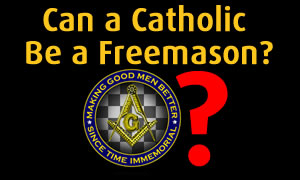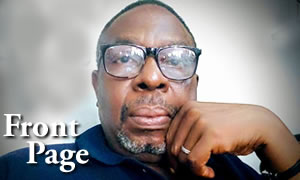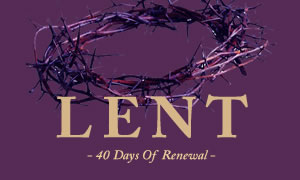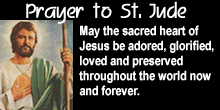


 A Talk delivered to The Forum of Catholic Knights in Ghana.
A Talk delivered to The Forum of Catholic Knights in Ghana.
Introduction
Many people regard Freemasonry as a benevolent and charitable organization, somehow similar to the Rotary and Lions Clubs, the Knights of Marshall, the Knights of St. John International or the Knights of Columbus. Undoubtedly, it is for this reason that some Catholics join this fraternity. Nevertheless, Catholics are forbidden to become Freemasons. The Catholic Church has opposed the Lodge nearly since the birth of modern Freemasonry in 1717. The Lodge has been condemned explicitly by eleven popes. What is Freemasonry and why is it condemned by the Catholic Church?
The History of Freemasonry
According to most historians of Freemasonry, the origins of Freemasonry can be traced to the stonemasons who built the magnificent cathedrals and castles of medieval Europe. These masons became known as “free masons” because, unlike the local guild masons, they were not indentured workers, i.e. they did not have to work under an unbreakable contract for a fixed period, in return for room and board, training, or pay.
These “free masons” organized themselves into closely-knit groups to protect their identity and working practices. The masons’ guilds were at first limited to stonecutters, but after the Reformation had virtually put an end to the construction of new church buildings, the Masonic lodges, whose numbers were diminishing, began to admit to their ranks “honorary” or non-working members who had no idea of how to wield a trowel or a chisel. Among these were philosophers, merchants and bankers. These were known as “accepted” masons.
In due course, the honorary members outnumbered the operative masons (those who built physical structures) and adopted the symbols and secret signs of the lodges to form what became known as “speculative” Masonry whose members build the “spiritual temple” (a Masonic expression for the soul).[1] Today, Freemasonry is entirely speculative, although its operative background has left its mark in the ritual use of such tools as the square, level, plumb, compass and trowel. These symbols of masonry now serve as guides for living a good moral life.[2] The guilds have thus become societies dedicated to general ideals, such as fraternity, equality and peace, and their meetings are more social than business occasions.
Modern Freemasonry was born in London on 24 June 1717 in the Apple Tree Tavern, during the period of the Enlightenment. On that day, four or more guilds, called lodges, came together in London to form a grand lodge for London and Westminster, which, within six years, became the Grand Lodge of England. This Grand Lodge, known as the “Modern Grand Lodge”, developed the blueprint for rituals and ceremonies that Masons use today. This body is the “mother” grand lodge of Freemasons in the world and has given birth to all recognized grand lodges.
Some Masonic non-conformists, who claimed that the rituals of the Modern Grand Lodge de-christianized Freemasonry, established the rival Ancient Grand Lodge. The two Grand Lodges existed side by side as rivals from 1751 to 1813, when they merged to form the United Grand Lodge of Ancient Freemasons of England. Today, all regular lodges in the world trace their origins to the Grand Lodge of England.
Freemasonry in America
Freemasonry was brought to American shores from England not too long after the establishment of the first Grand Lodge. The earliest of the U.S. lodges, founded by authority of the Grand Lodge of England, were the First Lodge of Boston, established in 1733, and one in Philadelphia, established about the same time. By the time of the American Revolution, about 150 lodges existed in colonial America.
Freemasonry in Ghana
Freemasonry was introduced in Ghana, then Gold Coast, through Lodges under the English Constitution as far back as 1859. The practice of Freemasonry has been in continuous existence in Ghana since 1859. Today, altogether 49 subordinate Lodges constitute the Foundation Lodges of the Grand Lodge of Ghana and are found in such places as Accra, Kumasi, Cape Coast, Sekondi, Takoradi and Tarkwa.
The Lodges have been grouped into three Provincial Grand Lodges, namely, (1) Provincial Grand Lodge, South East based in Accra with 20 Lodges. (2) Provincial Grand Lodge, South West based in Cape Coast with 17 Lodges and (3) Provincial Grand Lodge, North based in Kumasi with 12 Lodges.
Some very prominent Ghanaians are known to be members of Masonic Associations. Some Christians, indeed some Catholics, are also known to be Freemasons.
Influences on Freemasonry
Freemasonry takes much from the world’s three great religions. It takes many of its practices from Christianity. The Bible is usually placed on the altar, and passages from the New Testament are woven into the rituals (though the word “Christ” is always omitted from the texts).
Freemasonry also draws extensively from Judaism. The setting for the three Masonic degrees is “King Solomon’s Temple”. Masonry also borrows from Islam, especially in the rituals of the Shriners, a secret fraternal non-Masonic organization whose members are Knights Templars and 32nd-degree Masons. The Shriner’s oath is taken on the Koran and sworn to Allah.
In addition to the world’s three major religions, Freema¬sonry also borrows from Deism, a rationalist religious philosophy that flourished in the 17th and 18th centuries, particularly in England. Deism sought to liberate people’s minds from the “oppression” of dogma and ecclesiastical authority in favour of dis¬cerning truth through the rational study of nature.
Deism maintained that there was no room for divine revelation. The Masonic rituals developed by the Grand Lodge of England reflect the influence of Enlightenment philosophy, the bedrock of Deism. Freemasonry’s degrees did away with Christian prayer and any references to Catholicism. A Mason was now required to believe only in the deistic “Great (or Grand) Architect of the Universe” and an afterlife. This belief makes it possible for Jews, Deists and Muslims to become members, but supposedly barred atheists and polytheists.
Apart from Christianity, Judaism and Islam, Freemasonry draws from Gnosticism[3] in its search for eso¬teric spiritual knowledge that is not available to the uninitiated.[4]
Freemasonry and the Catholic Church[5]
The Catholic Church has opposed the Lodge nearly since the birth of modern Freemasonry in 1717. Since the founding of the Grand Lodge of England, eleven popes have explicitly condemned Freemasonry or Masonic principles. These popes are: Pope Clement XII (28 April 1738); Pope Benedict XIV (18 May, 1751); Pius VII (13 September 1821); Pope Leo XII (13 March 1825); Pope Pius VIII (24 May 1829); Pope Gregory XVI (15 August 1832); Pius IX (between 1846 and 1873); Leo XIII (15 February 1882; 20 April 1884; 1887; 15 October 1890; 18 December 1892; 20 June 1894); Pope Pius IX (1907); Pope Pius X (1907); Pope Pius XI (1924).
The most recent condemnation of Freemasonry is contained in the “Declaration on Masonic Associations” issued by the Congregation for the Doctrine of the Faith on 26 November 1983. This document, which was written by Cardinal Joseph Ratzinger (the future Pope Benedict XVI) and approved by Pope John Paul II, declared that Masonic principles are irreconcilable with the doctrine of Church, and that Catholic membership in Freemasonry remains forbidden. The full text is as follows:
CONGREGATION FOR THE DOCTRINE OF THE FAITH DECLARATION ON MASONIC ASSOCIATIONS
It has been asked whether there has been any change in the Church’s decision in regard to Masonic associations since the new Code of Canon Law does not mention them expressly, unlike the previous Code.
This Sacred Congregation is in a position to reply that this circumstance is due to an editorial criterion, which was followed also in the case of other associations likewise unmentioned inasmuch as they are contained in wider categories. Therefore, the Church’s negative judgment in regard to Masonic association remains unchanged since their principles have always been considered irreconcilable with the doctrine of the Church and therefore membership in them remains forbidden. The faithful who enrol in Masonic associations are in a state of grave sin and may not receive Holy Communion.
It is not within the competence of local ecclesiastical authorities to give a judgment on the nature of Masonic associations which would imply a derogation from what has been decided above, and this in line with the Declaration of this Sacred Congregation issued on 17 February 1981 (cf. AAS 73 1981 pp. 240-241; English language edition of L’Osservatore Romano, 9 March 1981).
In an audience granted to the undersigned Cardinal Prefect, the Supreme Pontiff John Paul II, approved and ordered the publication of this Declaration, which had been decided in an ordinary meeting of this Sacred Congregation.
Rome, from the Office of the Sacred Congregation for the Doctrine of the Faith, 26 November 1983.
Joseph Card. RATZINGER
Prefect
+ Fr. Jerome Hamer, O.P.
Titular Archbishop of Lorium, Secretary


I have been thinking a great deal about my experience at Reconciliation this past Saturday. I felt an intense and unexplainable urge to go and confess my sins when I woke up that morning. I try to go every six weeks or so, but this was no routine visit to the priest for me. I needed to unburden myself of the numerous venial sins I had committed since I last participated in this Sacrament.
Purest Gold: God's Refining Fire in our Lives »
After salvation, many young Christians wonder if there's anything more to their newfound faith than just the security blanket of "being a Christian." Time and time again, God shows himself as a "refiner," and our lives are as gold. God started leading me in this study to understand what He was doing in my life, as well as in the lives of others.
Picking up my pen to write this column, I couldn’t imagine how time flies. Since the last publication of this column I have gone through a lot, especially the loss of my dear mother to whom I dedicate this article. Not only her, but seems I lost a whole generation of my close family.
How to Achieve Business Excellence »
“Do you see a man who excels in his work? He will stand before Kings; He will not stand before unknown men.” Proverbs 22:29
Spiritual Development for our Youth »
Most of us youth in today's fast moving world are easily thrown off by difficulties and worries.
The theme of conversion is a thread that runs all through Lent, but conversion takes on different aspects throughout the phases of Lent. The first two and a half weeks focused on the interior turning of hearts; the liturgy urges the faithful to reflect and examine consciences thoroughly.
Saint Josephine Bakhita »
Feast Day: February 8
Patron Saint Of: Sudan
Saint Josephine Margaret Bakhita was born around 1869 in the village of Olgossa in the Darfur region of Sudan. She was a member of the Daju people and her uncle was a tribal chief. Due to her family lineage, she grew up happy and relatively prosperous, saying that as a child, she did not know suffering.
Catholics Must Fast More Intensely This Lent»
The Norbertine Canons of St. Michael's Abbey have created this digital Lenten retreat so that you can journey through this holy season alongside them. If you want to have one of your best Lenten seasons yet, join us in our Lenten Program "The Great Fast" - https://theabbotscircle.com/the-great-fast-join
When Your Faith Is Put to the Test - Bishop Barron's Sunday Sermon»
Friends, we come now to the Second Sunday of Lent, and we’re on both dangerous and very holy ground with the first reading from the twenty-second chapter of Genesis. The ancient Israelites referred to it as the “Akedah,” which means the “binding”: Abraham binds and is ready to sacrifice Isaac at God’s command.

Copyright © 2002-2024 THE BEACON INTERNATIONAL CATHOLIC MAGAZINE. All rights reserved.
another mc.rufus interactive web design